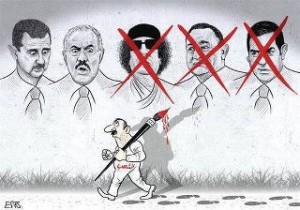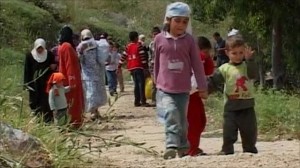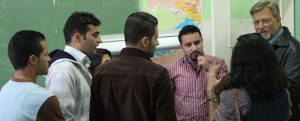Sitting with Gilbert Achcar and several of my UC Davis Jewish Studies and Middle East Studies colleagues in a local café after a talk on his book The Arabs and the Holocaust, the conversation turned to Syria.
Achcar’s conclusion, which I share (as does the UN) is that Syria is on the road to civil war. Indeed, I would argue that parts of Syria, in particular the cities of Homs, Hama and Idlib and their hinterlands are already in a state of civil war. Those cities have been placed under siege, death squads roam them in broad daylight rounding up and “disappearing” civilians and uniformed security forces fight running gun battles with bands of defectors who are often just defending their neighborhoods.
Still protestors take to the streets each Friday like they have since last March and each Friday dozens are killed. Over 3000 so far, including some 190 children. This persistent courage in the face of unrestrained brutality inspires not just heart rendering awe, but also confirms how resilient the Syria opposition is. This resiliency will force the Syrian régime to increase its use of organized violence and at some point the largely peaceful resistance will itself become violent, perhaps in a battle for the city of Homs.

The longer the conflict continues the more “international” it will also become. This isn’t in the sense of Libya, where Western forces sided with the Libyan TNC. There appears to be none of the international will to intervene in Syria that there was in Libya and various sanctions régimes have been blunted at the UN by Russian and Chinese opposition. Instead the international component of the civil war in Syria will be regional, with Iran extending support to the régime with help from Iraq and Lebanon’s Hizbollah and Saudi Arabia and Turkey providing assistance to the opposition, which is not coincidently dominated by Sunni Muslims, as well as help from Iraqi Kurdistan for Syria’s vast Kurdish population. Arms, money and military and cyberwar expertise are flowing into Syria from all sides.
With the coming of civil war in Syria, it is important to begin to anticipate what kinds of humanitarian challenges will arise and how the international community could mobilize to meet them. The Syria Civil War will resemble that of Iraq between 2006-2008 and Lebanon 1975-1990. It makes sense to draw some lessons from the humanitarian experience of those conflicts. What follows are some very preliminary thoughts and observations.
1) Like Iraq and Lebanon, very little distinction will be made between combatants and non-combatants.
This fact will have critical implications for refugee flows, the creation of IDPs, the safety of civilians in situ, and refugees in transit across international borders. The Iraqi experience shows how quickly large numbers of IDPs can result from civil conflict, especially if this civil conflict is accompanied by forms of ethnic cleansing. The kind of ethnic cleansing that accompanied the civil war in Iraq, in particular in Baghdad, is unlikely in Syria.
Still minor refugee flows out of Syria over the last few months give some indication of where major flows will go: from northwestern Syria into the Turkish province of Hatay and from central Syria into northern Lebanon. In both of these cases people moving probably have relatives on the other side of the border. Currently the UNHCR is providing assistance to about 3200 Syrians who have fled to Wadi Khalid, which is just across the border from Homs. I’m also certain that three to four times this number of Syrians has already crossed into Lebanon, but those refugees have not registered with the UN. Recent cross border raids by Syrian forces into Lebanon to seize deserters and opposition figures confirms that Syrian refugees in Lebanon are not safe. Lebanon is in no position to oppose these incursions even if there were political will in Beirut to do so.

Syrian Refugees in Lebanon, October 2011
Attacks on Kurds in Syria’s Mesopotamia will force Kurds into Iraqi Kurdistan where the problem will be less political will to assist, but rather logistical support. Indeed Iraqi Kurdistan could provide a very useful staging ground for refugee assistance.
The Turkish border is more militarized and the Turkish military more able to provided needed protection. A possible option looking forward is the creation of a humanitarian corridor into Turkey through the Orontes River Valley, which would allow safe passage out of Homs, Hama and Idlib. There are a host of other political problems with direct Turkish intervention in Syria, not the least of which are fears of Ankara’s Neo-Ottomanist designs on the Levant. Nevertheless, any meaningful international commitment to the safety of Syrian refugees will require humanitarian intervention in Syria.
2) Like Iraq and Lebanon, violence will have political and sectarian dimensions.
Rightly or wrongly the régime of Bashar al-Assad is associated with the entirety of the Alawite minority in Syria. The security apparatus and military elite in Syria is dominated by Alawites. There will be ethnic reprisals in the civil war. The most vulnerable populations, however, as was the case in Iraq, are the urban and rural Christian minorities. A possible example of the shape of things to come came last week when a bomb exploded in the Armenian Orthodox Church in the Damascus’s old city. It is unlikely that this bomb was set by régime opponents. What is probably the case is that it was planted by state security forces as a message to the city’s Armenians that were they to support the opposition that they would face further attacks and/or that they would no longer be protected by the state from extremist violence. Christians are disproportionately represented in Iraq’s refugee diaspora and it is likely that this would reoccur in Syria. What this speaks to though is that where mass violence is probable, genocide is possible.
The West ignores the possibility of genocide in Syria at the peril of any humanitarian credibility it has achieved with successes in Libya.
Along the same lines, Syria remains one of the primary locations for refugees from Iraq – some 1.3 million with several thousand active asylum seekers. Stepped up efforts to resettle and return these refugees would help reduce the possibility that this extremely vulnerable group would become victims of another conflict.
Syria’s problems and years of misery are just beginning.








